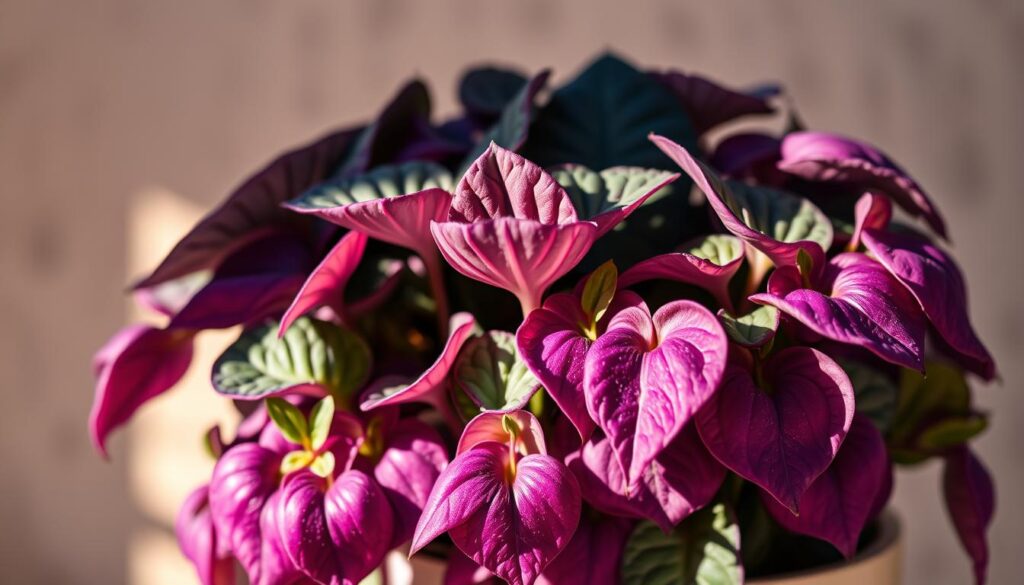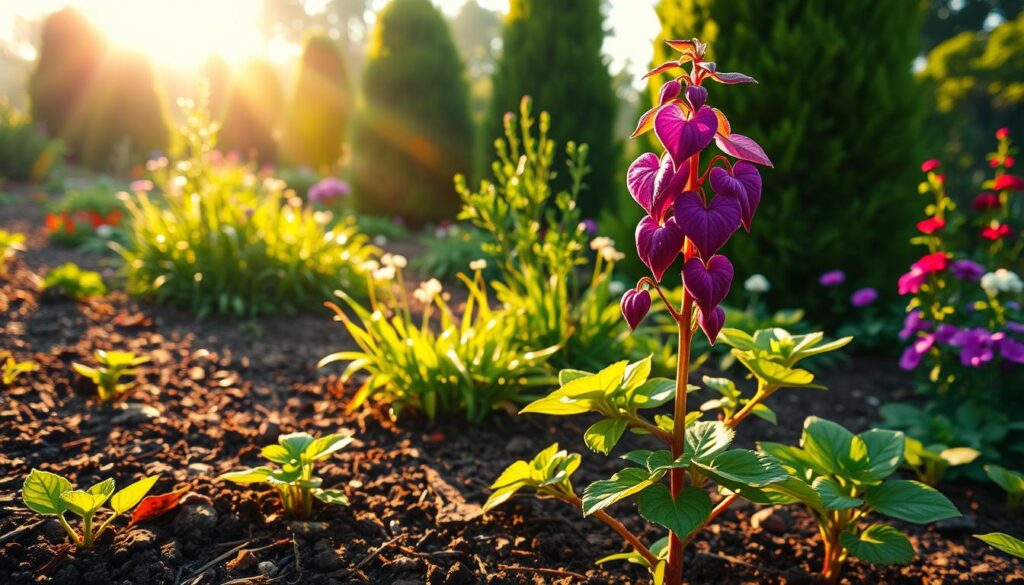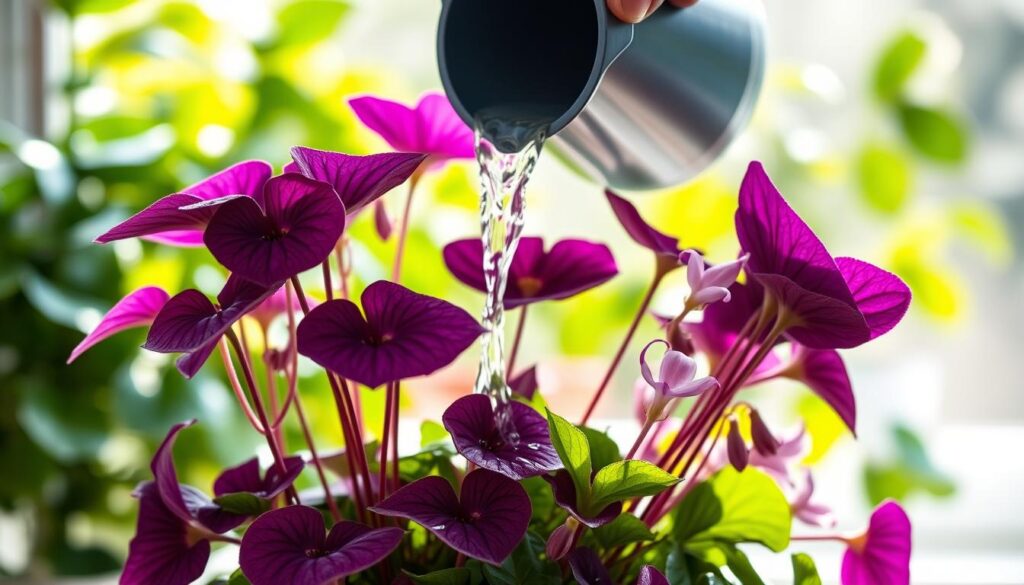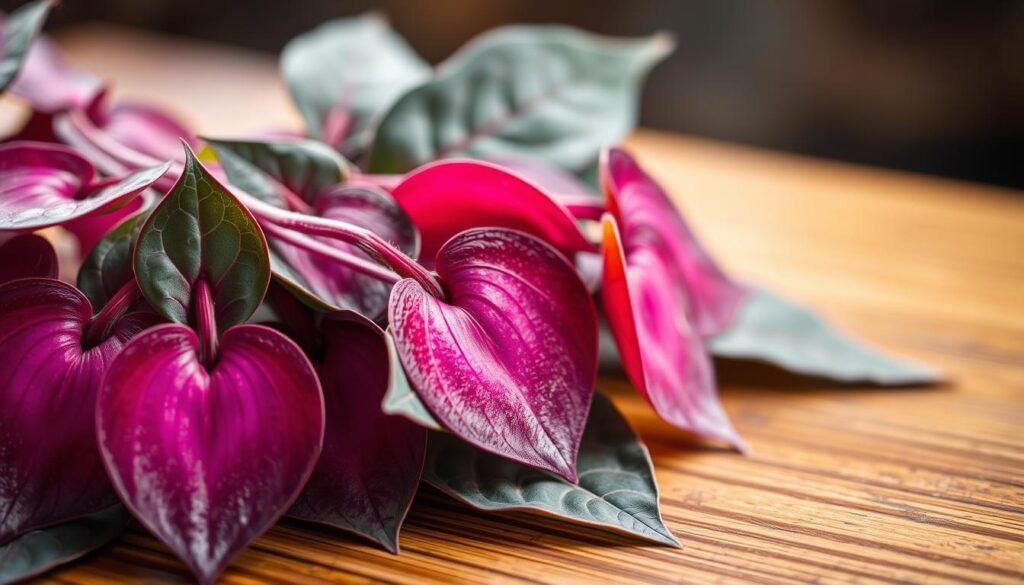The plant purple heart, known as Tradescantia pallida, is a standout in any garden or indoor spot. Its deep purple leaves add a pop of color to any setting. It’s native to Mexico and also known as purple wandering jew, making it both beautiful and easy to care for.
Key Takeaways
- Tradescantia pallida offers striking purple foliage that thrives in full sun or partial shade.
- It requires minimal watering, making it ideal for busy gardeners.
- Perfect for ground cover, hanging baskets, or mixed planters.
- Resistant to drought and deer, it’s a resilient choice for outdoor spaces.
- Easy to propagate, expanding your garden without extra effort.
Introduction to the Stunning Plant Purple Heart
The plant purple heart, known as Tradescantia pallida, is loved for its bright color and toughness. It comes from Mexico’s sunny slopes and is now a favorite worldwide. Let’s dive into its story and why it’s a hit in modern gardens.
The Origin Story of Tradescantia Pallida
The Tradescantia pallida origin is from Mexico’s dry areas. It grows well in rocky, sunny spots. Botanists first noted it in the 19th century and brought it to gardens globally. Its move from wildflower to garden favorite shows its ability to adapt.
Why Gardeners Love This Vibrant Trailing Plant
- Low maintenance: It can handle drought, saving water.
- Showstopping color: Its deep purple leaves brighten any area all year.
- Easy propagation: It spreads quickly from cuttings, filling gaps fast.
Purple Heart Plant’s Place in Modern Landscaping
As a purple heart trailing plant, it shines in creative designs. It’s great for:
- Rock gardens for texture
- Hanging baskets for a flowing look
- Xeriscapes to save water and look good
Its flexibility makes it a key piece in both formal and casual gardens. It’s more than a plant—it’s a design must-have.
Identifying Characteristics of Purple Heart Plants
Learning to identify plant purple heart identification begins with its eye-catching purple heart foliage. These leaves are smooth and spoon-shaped, growing in a rosette pattern. They show off rich violet to deep purple colors. The Tradescantia leaf structure is thick and fleshy, making it tough against drought but also delicate-looking.

The purple heart flowers bloom in summer, adding a burst of pink-lavender color. These small flowers have three petals and appear sporadically. Trailing stems can grow up to 2 feet long, spreading quickly to form dense mats. Here’s how to spot one at a glance:
- Leaves: Heart-shaped, 2–3 inches long, with metallic sheen
- Stems: Creeping, rooting at nodes to form new plants
- Flower clusters: Small but showy, blooming May through September
| Feature | Description |
|---|---|
| Leaf Color | Purple to bronze-green depending on light |
| Flower Lifespan | 2–3 days per bloom, but continuous clusters |
| Leaf Texture | Smooth, slightly glossy surface |
Not sure if it’s Tradescantia pallida or another plant? Look at the leaf edges. True purple heart foliage has smooth margins without serrations. This hardy perennial does well in full sun but also keeps its color in partial shade. It’s easy to spot in gardens or nurseries.
Creating the Perfect Growing Environment
Mastering plant purple heart care starts with understanding its core needs. Let’s break down the key factors for success:
Ideal Light Conditions for Thriving Purple Hearts

These sun-loving plants crave purple heart light requirements of 6-8 hours of bright light daily. Full sun boosts their signature purple hues, while partial shade keeps them vibrant in hotter climates. Indoors? Place near east- or west-facing windows. Avoid deep shade to prevent green fading.
- Outdoor: Full sun to part shade (60%-70% coverage)
- Indoor: Bright indirect light for 6+ hours
Temperature and Humidity Requirements
As a purple heart growing conditions expert, know this: thrive in 60-85°F (15-30°C). Frost kills them—USDA zones 7-10 only. In colder zones, treat as annual or overwinter indoors. No humidity needs, but avoid wet soil in winter.
“In zone 7, mulch roots deeply before first frost.”
- Winter prep: Bring potted plants indoors
- Protect outdoor plants with frost cloths
Soil Composition and Drainage Needs
Choose fast-draining Tradescantia pallida soil mixes. Amend soil with perlite or coarse sand for airflow. Avoid heavy clays. Test drainage by watering—should drip from pot holes within 15 minutes.
- Soil pH: 6.0-7.5 (slightly acidic to neutral)
- Add 20% compost for nutrients
Pair these steps with regular checks for pests and adjust conditions seasonally for lush growth.
Watering and Feeding Your Purple Heart
Proper plant purple heart watering starts with respecting its Tradescantia pallida drought tolerance. This plant does well in dry conditions but needs regular care to stay colorful. Too much water can cause root rot, so let the soil dry out completely between waterings.

- Water deeply when the top 2 inches of soil are dry. Use your finger to test moisture levels.
- Adjust frequency by season: weekly watering in summer, monthly in winter.
- Signs of overwatering include wilting leaves and soft stems. Let soil dry fully if this occurs.
Feed with a balanced purple heart fertilizer diluted to half strength. Apply every 6-8 weeks during spring and summer. Avoid feeding in winter to match its natural growth cycles.
Purple heart plant maintenance is easy. Prune dead leaves to encourage new growth. Use well-draining soil and avoid heavy mulch, which can trap moisture. A light feeding in early spring can boost color without stressing the plant.
Propagation Methods for Expanding Your Collection
Make your garden bigger with these easy steps. You can share plants with friends or grow more for yourself. Plant purple heart propagation is a fun DIY project. Follow these steps to grow more of your favorite plants.

Stem Cutting Techniques
Start with purple heart cuttings for quick results. Use clean shears to cut 4–6 inch stems. Remove lower leaves, leaving 2–3 at the top. Place in water or moist soil.
Roots will appear in 1–2 weeks. For soil planting, dip the cut end in rooting hormone powder first.
- Cut just below a leaf node
- Change water every 3 days
- Transplant to soil once roots reach 1 inch
Division of Mature Plants
In spring, divide crowded clumps using the Tradescantia pallida division method. Gently lift the entire root ball and tease apart sections with a spade. Each division should have healthy roots and shoots.
Replant immediately in prepared soil.
“Division revitalizes parent plants and gives you free new specimens.” – Green Thumb Gardens
Tips for Successful Rooting
Ensure success with these pro tips for rooting purple heart plants:
- Use sterile pots to avoid rot
- Keep soil lightly moist but never soggy
- Place in bright, indirect light
- Protect from frost during early growth
Propagation isn’t just practical—it’s a chance to grow your garden’s beauty exponentially. With patience and these steps, you’ll soon have thriving new plants to enjoy or share.
Seasonal Care and Maintenance Tips
Maintaining a purple heart plant means adjusting care with the seasons. Follow these plant purple heart seasonal care strategies for year-round beauty.
In spring, prune damaged stems and start monthly fertilization. Trim overgrown areas to shape the plant and promote bushy growth. This pruning Tradescantia pallida step prevents overcrowding and encourages new leaves.
Summer heat requires deep watering every 7-10 days. Avoid overwatering—soil should dry between waterings. Trim leggy stems regularly to keep the plant compact.
Winter care for purple heart depends on your climate. In zones below USDA 8, move plants indoors or mulch heavily. Reduce watering, and place in a sunny window. Outdoor plants in mild climates need frost protection and reduced feeding.
Year-round purple heart plant maintenance includes monthly pest checks and removing spent flowers to limit self-seeding. In frost-free areas, prune aggressively each spring to control spread. Always disinfect tools after cutting to prevent disease.
Landscaping and Design Ideas with Purple Heart Plants
Make your garden a showstopper with the purple heart plant’s striking foliage. Whether you’re plant purple heart landscaping or adding pops of color in containers, its versatility shines. Here’s how to design with this vibrant trailing plant.
Purple Heart as a Ground Cover
Use purple heart ground cover to fill empty spaces. Plant 12–18 inches apart in sunny spots for full coverage. Mulch soil to retain moisture and suppress weeds. This Tradescantia variety thrives as a low-maintenance solution for slopes or garden beds.
Container and Hanging Basket Arrangements
Bring vertical flair with Tradescantia container ideas. Try these styles:
- Hanging baskets: Fill with soil and let vines cascade over edges.
- Window boxes: Pair with upright plants like geraniums for layered looks.
- Stacked pots: Plant in tiered planters for a cascading waterfall effect.
Purple Heart Companion Plants
Enhance its purple hues with strategic pairings. Purple heart companion plants like these create eye-catching contrasts:
| Companion Plant | Why It Works | Best Pairing Tips |
|---|---|---|
| Golden creeping Jenny | Yellow-green leaves pop against purple. | Plant in clusters for sharp color clash. |
| Blue fescue grass | Silver-blue blades add texture. | Position in small groups for contrast. |
| Red begonias | Bright blooms complement foliage. | Cluster near the plant’s base. |
Experiment with these ideas to make your garden a standout space. Mix and match to highlight the purple heart’s unique beauty.
Troubleshooting Common Purple Heart Plant Problems
Even hardy plants like Tradescantia pallida face challenges. Spotting plant purple heart problems early ensures quick fixes. Let’s tackle the most frequent issues gardeners face:
- Pests: Purple heart pests like spider mites, mealybugs, and aphids weaken leaves. Check undersides for webbing or sticky residue. Spray with neem oil for organic control or insecticidal soap.
- Diseases: Overly moist soil invites Tradescantia pallida diseases, such as leaf spot or root rot. Improve drainage and prune infected areas. Avoid overhead watering to prevent fungal growth.
- Environmental Stress: Leggy stems signal too little light. Trim back and move to brighter spots. Frost damage? Prune dead tissue and shield plants with frost cloth in winter.
- Overwatering: Yellowing leaves mean too much water. Let soil dry between waterings. Repot in well-draining mix if roots are mushy.
“For reviving purple heart plants, start with cultural adjustments before chemicals,” advises gardening expert Sarah Green. “Adjust light, trim damaged parts, and monitor soil moisture.”
Most issues resolve with consistent care. Act fast at first signs of trouble, and your purple heart will bounce back. Healthy plants reward you with vibrant foliage year after year.
Conclusion: Why the Purple Heart Plant Deserves a Place in Your Garden
The purple heart plant is a stunning choice for gardens in the U.S. It boasts vibrant foliage that looks great in sun or shade, adding color all year. As a Tradescantia pallida, it does well in poor soils and hot weather. It’s also drought-tolerant, making it perfect for those who don’t have a lot of time to garden.
This plant is more than just pretty. It attracts pollinators and cleans the air when kept indoors. Gardeners in Arizona and Florida love it for its ease in filling containers or ground covers. It’s tough and works well in any garden design.
Ready to add some purple charm to your garden? A purple heart plant brings instant beauty without needing constant care. It’s great in borders, pots, or mixed beds, adding a lively touch. Check out local nurseries or online stores to find varieties. Your garden will love the bursts of purple it brings.



